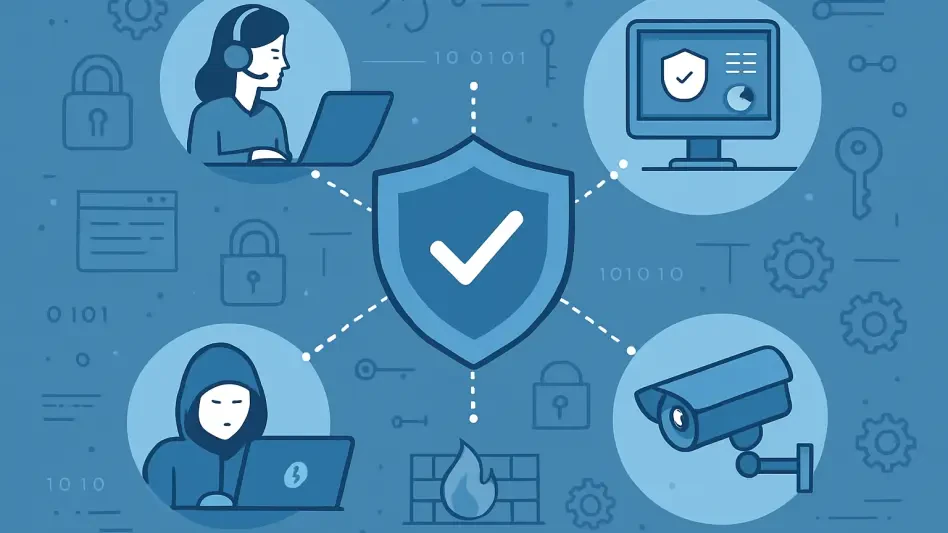In a world where security threats are becoming more intricate and unpredictable, the path forward for corporate safety lies in adopting a model of connected operations that transcends outdated, isolated methods, emphasizing the integration of systems, technologies, and cross-departmental teams. This approach creates a unified and efficient framework capable of tackling modern challenges. Far from being a fleeting trend, connected operations represent a vital shift as businesses grapple with risks that demand innovative collaboration. By weaving together security with IT, operations, and other key functions, organizations can address vulnerabilities from a comprehensive angle, creating resilient structures that adapt to dynamic environments. The promise of this interconnected strategy extends beyond mere protection, offering a way to streamline processes and enhance overall efficiency. As this transformative concept gains traction, it becomes evident that envisioning security as part of a broader ecosystem is not just beneficial but essential. Exploring this topic reveals how imagination, strategic planning, and a commitment to integration can unlock unparalleled advantages for companies aiming to safeguard their future.
Breaking Down Silos for Collaborative Strength
The foundation of connected operations rests on fostering collaboration across various departments within an organization. For too long, security decisions have been made in isolation, with individual teams such as security, IT, or operations selecting solutions without consulting one another. This disjointed method often leads to incompatible systems that are challenging to oversee and maintain, creating gaps in protection. Frequently, the lack of dialogue means overlooking straightforward fixes that could emerge from shared insights, such as when a security team seeks a new access control device while IT could suggest a more efficient software update. Establishing a culture of teamwork ensures that every perspective is considered, preventing fragmented efforts that undermine safety measures. This collaborative approach is not merely a suggestion but a critical step toward building a cohesive security strategy that stands up to evolving threats.
Moreover, cross-functional collaboration aligns security initiatives with the broader objectives of the organization, ensuring that solutions serve multiple purposes. When all stakeholders participate in the decision-making process from the outset, the resulting systems are not only more effective but also more sustainable over time. This inclusive method helps in identifying potential overlaps or conflicts between departmental needs, allowing for adjustments before implementation. The emphasis on breaking down silos fosters a shared responsibility for safety, where each team understands its role within the larger framework. By prioritizing communication and joint problem-solving, companies can create an environment where security becomes a unified goal rather than a series of disconnected efforts, paving the way for long-term resilience against risks.
Crafting a Unified Security Ecosystem
Connected operations thrive on the principle of viewing security as an integral part of a dynamic, interconnected ecosystem rather than a standalone operation. Adopting a broad, overarching perspective enables businesses to see how individual tools and protocols influence the entire organizational structure. This comprehensive outlook is crucial for recognizing the interdependencies between different systems, ensuring they function harmoniously to counter sophisticated threats. Unlike earlier times when isolated technologies were deemed sufficient, today’s complex risk landscape demands a shift toward integration. A unified ecosystem facilitates smoother responses to incidents by ensuring that all components work in tandem, reducing the likelihood of oversight or delay. This approach marks a pivotal change in how security is conceptualized and implemented across industries.
Additionally, building such an ecosystem allows for greater adaptability in the face of changing circumstances. When security solutions are designed with connectivity in mind, they can be more easily updated or expanded to address new challenges without disrupting existing operations. This interconnected framework also enhances visibility across the organization, providing real-time insights into potential vulnerabilities or breaches. By moving away from siloed tools, companies can create a more agile and responsive security posture that anticipates rather than merely reacts to threats. The focus on integration ensures that every element, from access controls to surveillance, contributes to a cohesive defense strategy, ultimately strengthening the organization’s ability to protect its assets and maintain operational continuity in an unpredictable world.
Harnessing Technological Innovations for Integration
The rapid evolution of security technology plays a central role in advancing connected operations, particularly through the power of software integration. Consider the transformation of electronic key management systems, which have progressed from basic storage units for emergency or fleet keys to advanced tools linked with access control platforms. These systems now offer real-time monitoring of key usage, temporary access provisions for external vendors, and automated alerts if keys are not returned within designated timeframes. Such innovations demonstrate how technology can extend beyond its initial purpose, providing multifaceted benefits that enhance both security and operational workflows. The ability to integrate these tools into broader systems exemplifies the potential for tech to revolutionize how organizations manage safety protocols.
Beyond specific examples, the broader impact of technological advancements lies in their capacity to connect disparate functions into a unified whole. Modern security solutions are designed to interact with other organizational tools, ensuring that data and alerts are shared seamlessly across platforms. This connectivity not only improves response times during incidents but also supports proactive measures by identifying patterns or anomalies that might indicate emerging risks. The role of technology in connected operations is not limited to solving isolated problems; it fosters an environment where every system contributes to overall efficiency and protection. As these innovations continue to develop, their integration into comprehensive security frameworks will remain a driving force behind safer, more streamlined corporate environments.
Empowering Decisions with Data and Scalability
At the core of connected operations lies the strategic use of data to inform and enhance security practices. Recent findings indicate that a significant majority of security and IT professionals are adopting software-driven solutions to optimize processes and gather actionable insights. This wealth of data provides a clear understanding of operational performance, highlighting areas of strength and pinpointing weaknesses that require attention. By leveraging analytics, organizations can maintain safer environments through evidence-based adjustments rather than relying on guesswork. The ability to collect and analyze information in real time transforms how security is managed, shifting the focus from reactive measures to preventive strategies that mitigate risks before they escalate. Data-driven decision-making is proving indispensable in navigating the complexities of modern threats.
Scalability, another vital advantage of connected operations, ensures that security systems can grow alongside the organization. Businesses expand at varying paces, and a unified infrastructure offers the flexibility to adapt without the complications of juggling disconnected tools. Whether a company is adding new facilities, increasing staff, or entering different markets, integrated systems can be scaled to meet these changing demands efficiently. This adaptability eliminates the need for constant overhauls or patchwork solutions that often arise from fragmented setups. By prioritizing connectivity, organizations can future-proof their security measures, ensuring they remain robust and relevant regardless of growth trajectories. The combination of data insights and scalability equips companies with the tools to build enduring, responsive frameworks for protection.
Tackling the Pitfalls of Fragmented Systems
Fragmentation poses a significant barrier to effective security, as independent systems often lead to inefficiencies that compromise safety. When tools and protocols operate in isolation, they become cumbersome to manage, scale, or integrate with other components. This lack of cohesion hampers an organization’s ability to respond promptly to threats, as critical information may not be shared across platforms in a timely manner. The resulting delays or miscommunications can exacerbate vulnerabilities, leaving gaps that malicious actors could exploit. Overcoming fragmentation through connected operations is not just a matter of convenience but a fundamental requirement for maintaining a strong defense against increasingly sophisticated risks in today’s landscape.
Furthermore, fragmented systems limit the potential for operational synergy, where the combined effect of integrated tools far exceeds their individual contributions. Without connectivity, monitoring and maintenance efforts become labor-intensive, draining resources that could be better allocated elsewhere. The inefficiencies of disjointed setups also hinder adaptability, making it harder for organizations to evolve their security measures in line with new challenges or regulatory requirements. Addressing these issues requires a deliberate shift toward integration, where every system is designed to communicate and collaborate with others. By eliminating the barriers created by fragmentation, connected operations enable a more streamlined, effective approach to security that maximizes both protection and resource utilization across the board.
Paving the Way for a Secure Tomorrow
Reflecting on the journey toward connected operations, it becomes clear that the security landscape has undergone a profound transformation by prioritizing integration over isolation. Companies that embrace cross-functional collaboration find themselves better equipped to tackle multifaceted threats, as shared insights lead to more robust solutions. The adoption of integrated ecosystems proves instrumental in enhancing visibility and responsiveness, ensuring that no aspect of security operates in a vacuum. Technological advancements, from sophisticated key management to software-driven analytics, redefine how organizations approach protection, embedding connectivity into every layer of their frameworks. Overcoming fragmentation stands as a defining achievement, as unified systems streamline efforts and fortify defenses against evolving risks. Moving forward, the focus should shift to continuous innovation and investment in scalable, data-driven tools that adapt to emerging challenges. Encouraging ongoing dialogue among departments will remain crucial, as will staying ahead of technological trends to maintain a proactive stance. The path ahead lies in building on these foundations, ensuring that security evolves as a cohesive, interconnected discipline capable of safeguarding organizations against whatever the future may hold.








